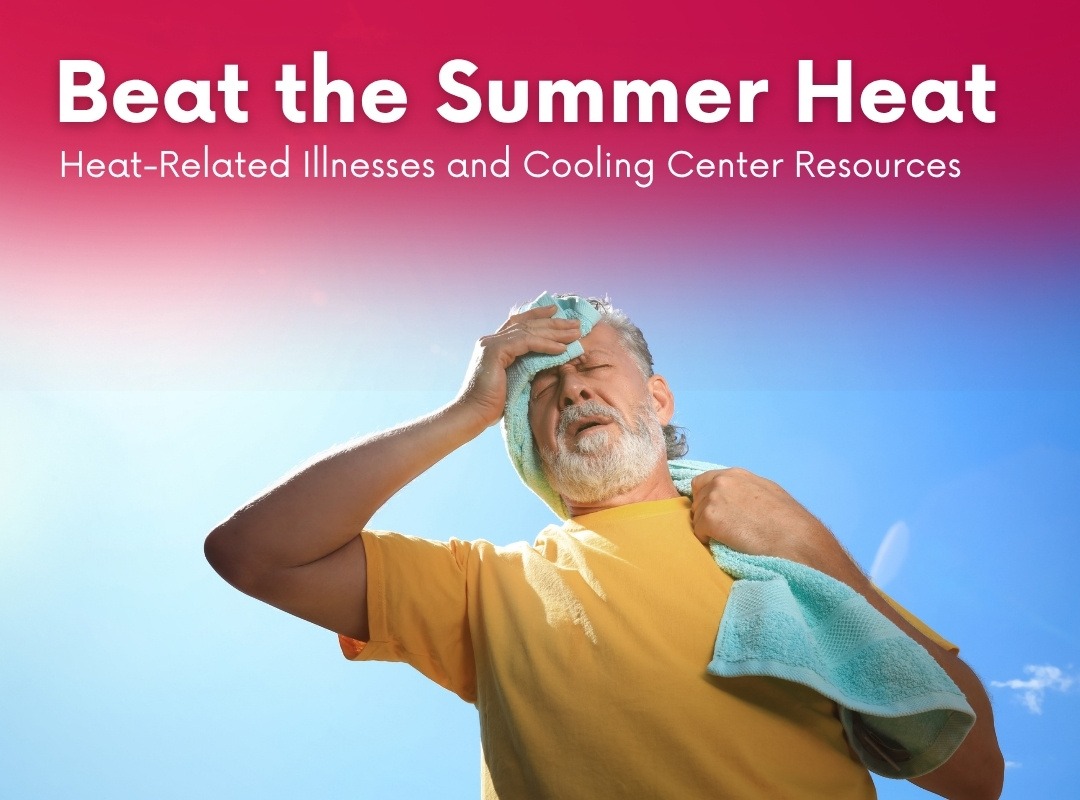Recent Posts
Beat the Heat this Summer
Understanding the different levels of heat-related illnesses and resources to find local cooling centers
As the calendar rolls into June, daylight hours and temperatures increase. Consistently hot temperatures pose the risk of developing into a heat wave. A heat wave is a period of abnormally hot weather that lasts 2 or more days in a row. These temperatures of 100°F and higher can cause stress on the body. These weather conditions are dangerous for anyone outdoors for long periods, as well as young children, the elderly, and those who are sensitive to temperatures for medical reasons.

What are Heat Cramps?
Heat cramps are painful muscle spasms, often in the legs, arms, or abdomen, that occur when the body loses too much water or salt through excessive sweating. Additionally, symptoms of heat cramps can include muscles feeling hard, lumpy, or tender, nausea, vomiting, fatigue, and weakness. While this is a mild form of heat-related illness, it can progress to a much more serious condition like heat exhaustion or heat stroke if not treated or addressed properly. Rehydrating the body with fluids with electrolytes, such as sports drinks, resting, stretching and massaging the affected muscles, and moving to a cooler place are great ways to combat heat cramps.
Source: https://www.cdc.gov/niosh/heat-stress/about/illnesses.html
What is Heat Exhaustion?
Heat exhaustion is a more severe heat-related illness that occurs when the body is exposed to high temperatures for a prolonged period of time, causing the body to overheat. In an effort to cool down, the body produces an excessive amount of sweat and loses fluids and electrolytes in the process. Pale and clammy skin, rapid and weak pulse, dizziness, lightheadedness, nausea, vomiting, headache, fatigue, weakness, muscle cramps, and loss of coordination are symptoms that can indicate heat exhaustion. Fainting because of heat is a more severe symptom that can indicate that you may be experiencing heat stroke rather than heat exhaustion.
Source: https://www.cdc.gov/niosh/heat-stress/about/illnesses.html
What is Heat Stroke?
Heat stroke is the most serious heat-related illness and occurs when the body is unable to cool itself down. The normal response to rising temperatures is for the body to produce sweat to cool itself. During heat stroke, the body’s temperature rises so rapidly that it causes this defense mechanism to fail, and the internal body temperature continues rising to dangerous levels. Symptoms of heat stroke include confusion, slurred speech, loss of consciousness, hot or dry skin, and very high body temperature. In severe cases, heat stroke can cause seizures, permanent disability, and even death.
If you believe you are or someone else is suffering from heat stroke, you should immediately call 911.
Source: https://www.cdc.gov/niosh/heat-stress/about/illnesses.html
How to Avoid Heat-Related Illnesses
The best way to avoid heat-related illnesses is to take the time to properly cool and care for yourself and your body when outdoors. Dress appropriately for the weather by choosing breathable fabrics and avoiding excessive layers of clothing to allow your body to get proper air flow. Adjust your physical activity by either reducing the intensity or duration of exercise or avoiding exercising during the times when the heat is at its peak. Staying hydrated by drinking cool fluids during and after your exercise, such as water or sports drinks, to rehydrate your body and replace any electrolytes lost.
Local Resources to Beat the Heat
Did you know that cooling stations are available throughout your community to help you stay cool and safe during the hot summer months? A "Code Red" is declared when it is expected to be at or above 100°F for two hours or more.
- Pottstown Cooling Stations (near CHDC Office at The Shoppes at Coventry Office):
- Pottstown Regional Public Library - 500 East High Street, Pottstown, PA 19464
- TriCounty Active Adult Center - 288 Moser Road, Pottstown, PA 19464
- Montgomery County Cooling Stations:
- Ann's Heart - Center for Emergency Resources at Ann's Heart (CERAH) - Sacred Heart Church, Phoenixville, PA 19460
- Montco Senior Adult Activities Center -526 George Street, Norristown, PA 19401
- Chester County Splash Pads:
- Bell Tavern Park in Downingtown - 107 Bell Tavern Rd, Downingtown, PA 19335
- John O. Green Memorial Park in West Chester - S. Matlack St and E. Miner St West Chester, PA 19380
- Marsh Creek State Park in Downingtown - 675 Park Rd, Downingtown
- Marsh Creek State Park in Downingtown - 183 Chalfont Rd, Glenmoore, PA 19343
- Paul Palmer Park in Coatesville - 115 N 9th Ave, Coatesville, PA 19320
- Berks County Cooling Stations:
- Reading Recreation Commission - Wacky Water Wednesday - Provides fire hydrants outfitted with a sprinkler head to give kids relief from the heat. Held at different locations each Wednesday - to see a list of locations, click the link.
Sources: www.chesco.org/4250/Extreme-Heat, www.montgomerycountypa.gov/573/Extreme-Weather---Heat
To find a cooling station near you, visit: PA 211 - Get Connected. Get Help, dial 211 on your phone, or text your zip code to 898-211.
If you would like to schedule an appointment at CHDC, please call 610-326-9460 or visit our Become Our Patient page.
